Decision making in the final third
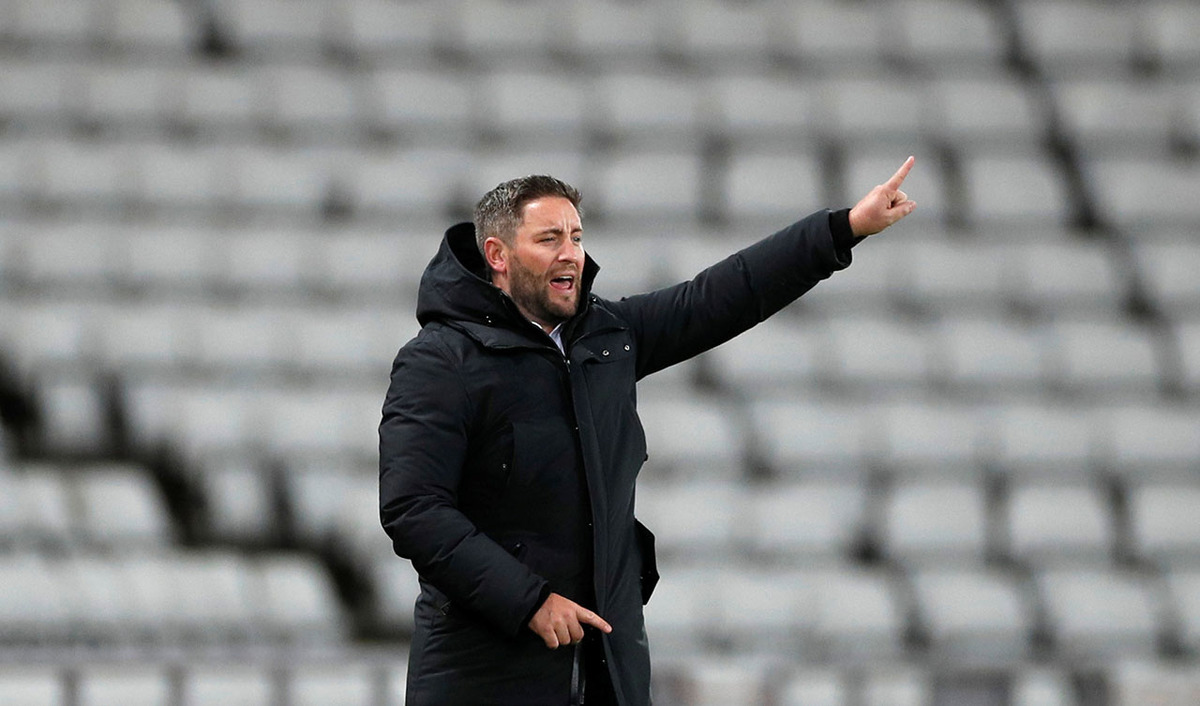
| Area | Up to half a pitch |
| Equipment | Balls, bibs, cones, 5 mannequins, 2 small target goals, 1 full size goal |
| No. of Players | Up to 16 players + 1 goalkeeper |
| Session Time | Technical practice: 15mins Opposed practice: 20mins |
This session is all about recognising the best opportunities for playing through, over or around the opposition’s defence. For example, running this session helps players to work out the best attacking options for the team, whether that is passing direct into the striker or playing an early ball out wide for a quick cross because the opposition’s back line is dropping.
There is no perfect answer to the questions we pose the players, but they have the freedom to be creative and play what they see within the constraints of the session.
As the session develops, I increase the difficulty and realism by adding opposition full backs and I try to motivate the defensive team by giving them the opportunity to counter-attack. To keep their interest high, I keep track of the score to motivate them further.
I would run this every two weeks, usually on a Tuesday or a Wednesday as the physical output is demanding because the session can have wave after wave of attacks. However, I would run the opening technical part of the session more often as this is physically less demanding.
“There is no perfect answer to the questions we pose the players, but they have the freedom to be creative within the constraints of the session”
TECHNICAL PRACTICE
We set up on the final third of the pitch with a goal and a goalkeeper in their usual positions. We place five mannequins outside the penalty area as shown. We’re using eight outfield players, positioned as shown, with four working down the right side of the pitch and four working down the left side. We begin by running a series of attacks down the right side of the pitch, utilising the four players on that side.
Attack 1 starts with the number 6 on the ball who passes into number 8. The number 8 turns and passes forward into the number 9, who sets the ball off with one touch for the number 8. He plays a through ball in behind the mannequin (that acts as a defending full back) for the forward run of number 7. The number 7 delivers the ball into the box for the number 9 to finish, ideally with one touch only, as shown [1a].
[1a]
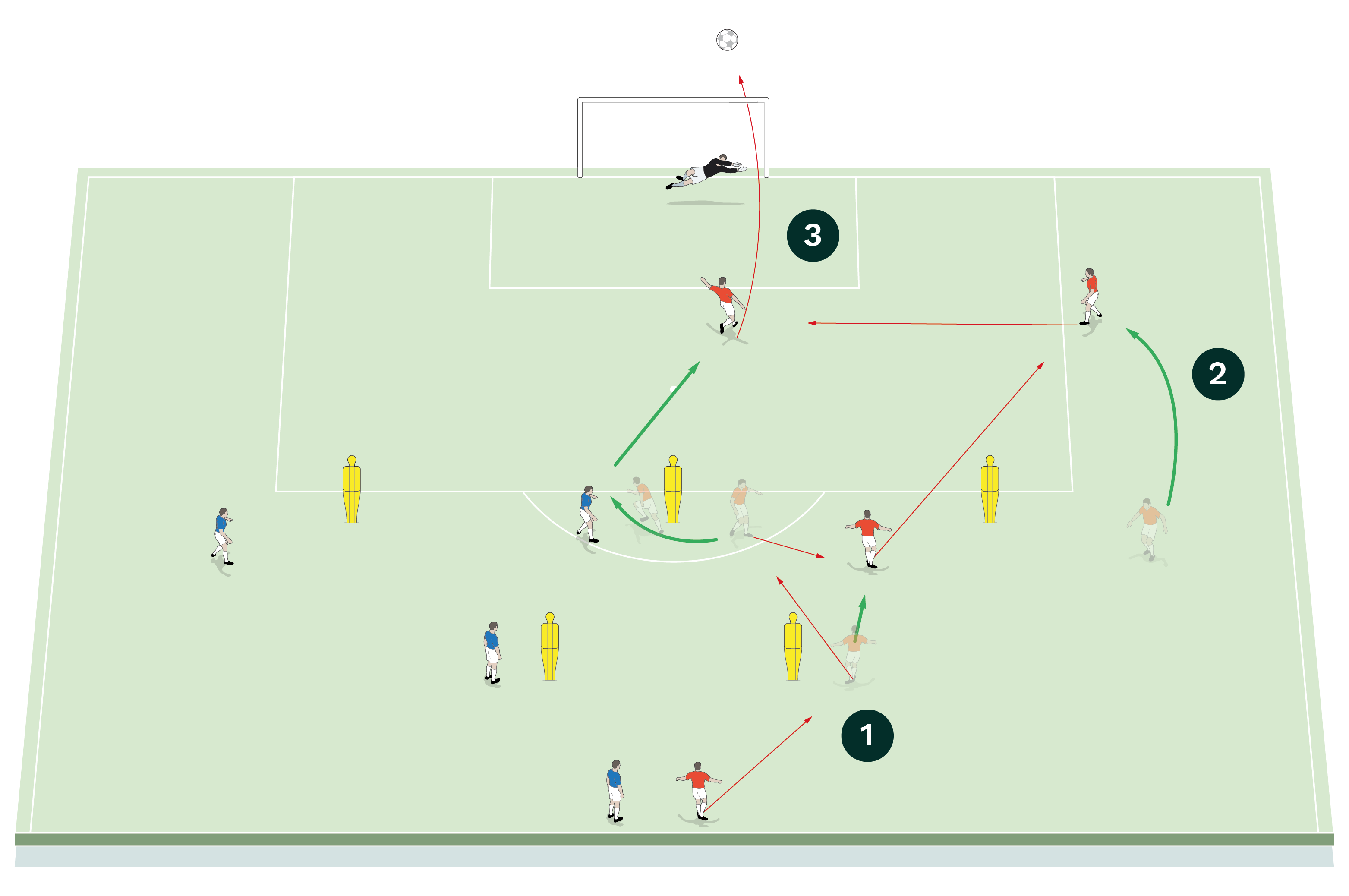
2. The number 8 plays a through ball in behind the mannequin for the forward run of the number 7
3. The number 7 delivers the ball into the box for the number 9 to finish with one touch
[1b]
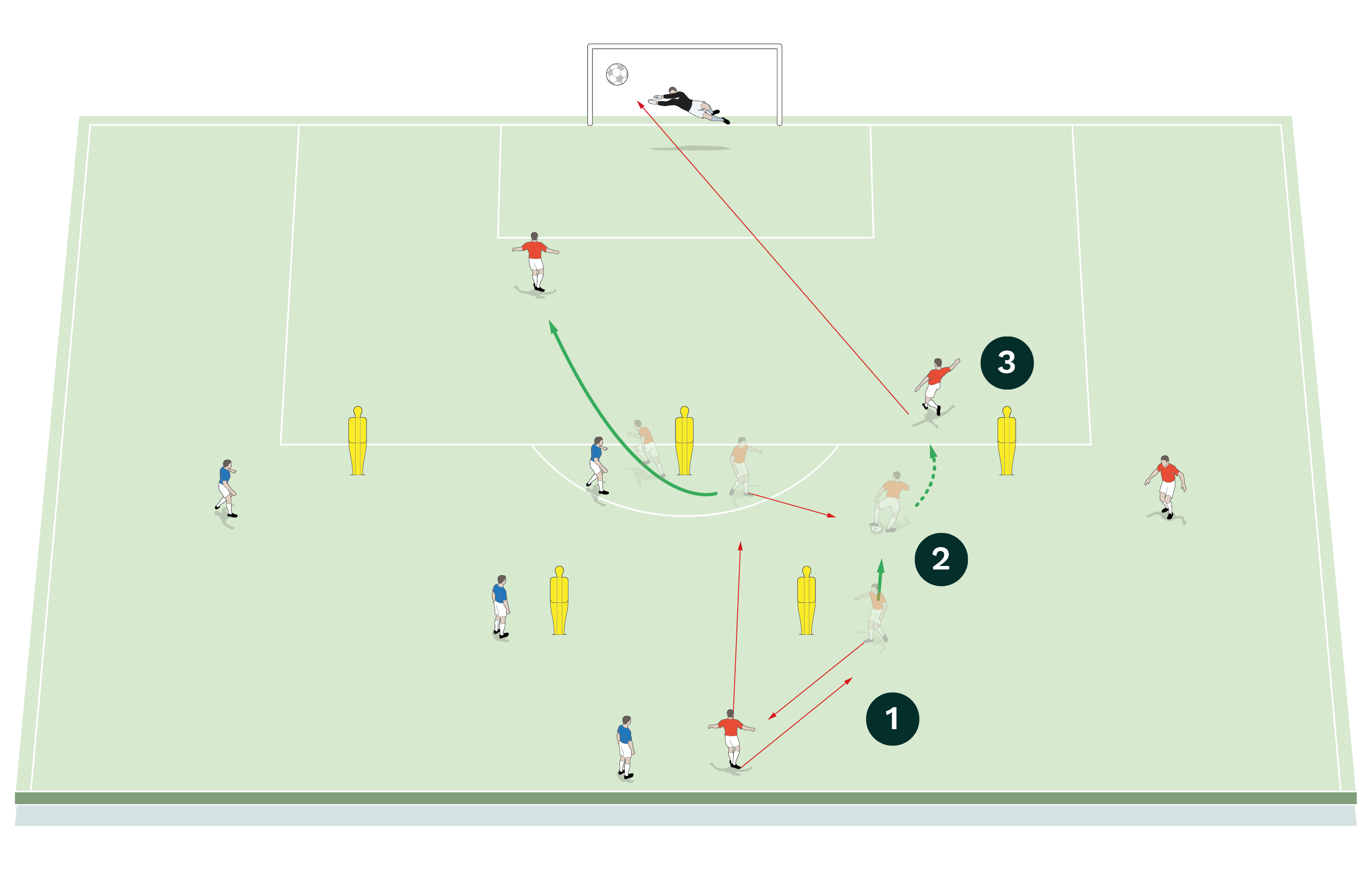
2. The number 9 sets for the number 8 to receive
3. The number 8 drives forward and takes a shot at goal
[1c]
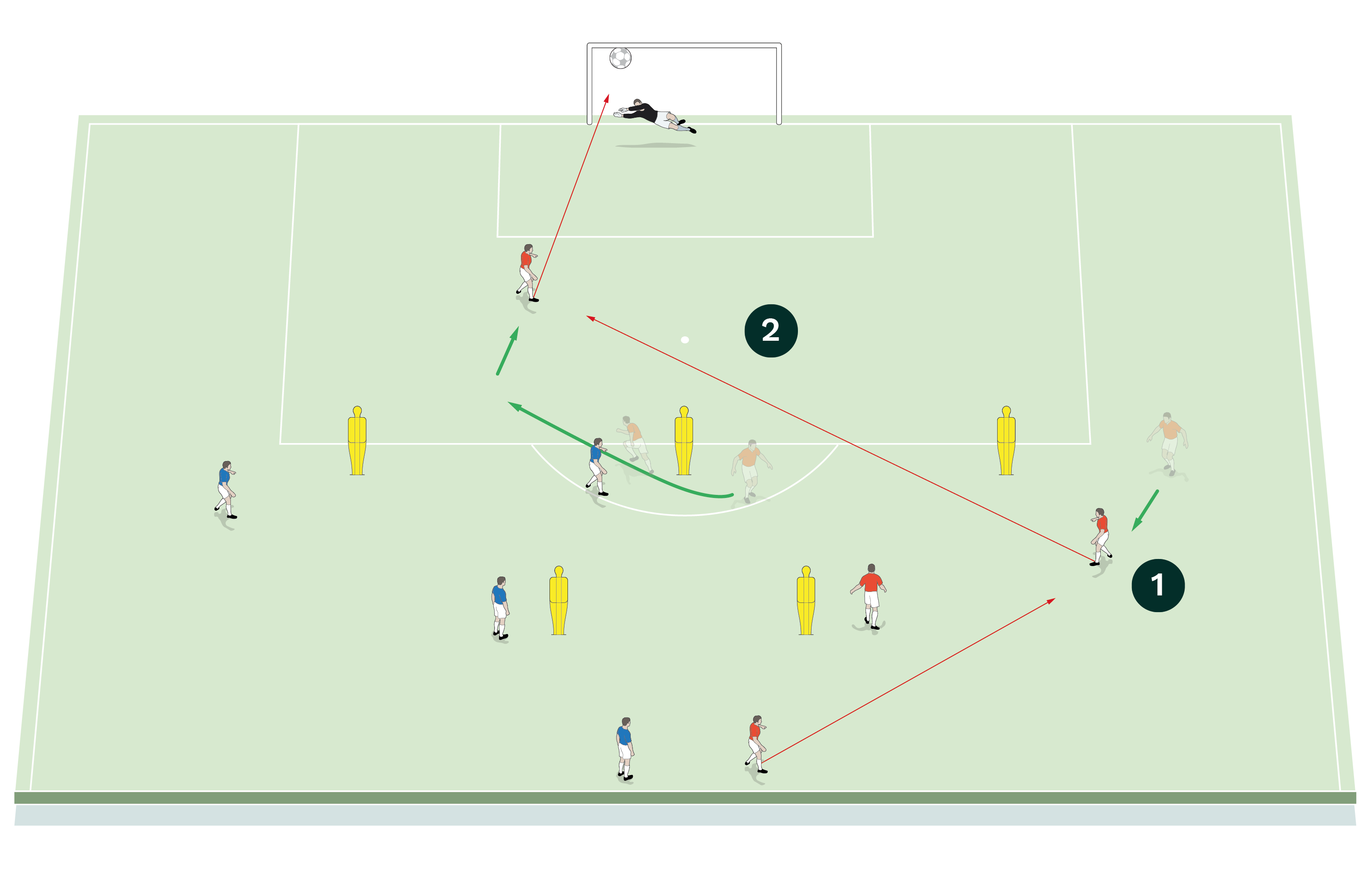
2. The number 7 receives and aims to play a longer ball into the POMO area in the box for the number 9 to finish
Attack 2 starts with the number 6, who bounces the ball off the number 8. The number 6 then plays into the number 9 who sets for the number 8 to receive. The number 8 then drives forward with the ball and takes a shot at goal, while the number 9 makes a back post run, as shown [1b].
Attack 3 starts with the number 6 playing directly out wide for the number 7, who has dropped to receive the ball. The number 7 receives and aims to play a longer ball into the POMO (position of maximum opportunity) area of the penalty box for the number 9 to finish with a shot on goal, as shown [1c].
Attack 4 starts with the number 6 passing the ball into number 8, who has made a movement behind the mannequin to receive centrally. The number 8 turns and drives across field with the ball before releasing a through pass for the forward run of number 7, who makes a blind side run either in behind or across the face of the mannequin full back. The number 7 finishes the attack with a shot on goal, as shown [1d].
After alternating the first four attacks down different sides of the pitch for seven minutes, we would then switch players onto the other side of the pitch and repeat all four attacks on both sides for another seven minutes. This would allow wingers the opportunity to be inverted and to finish with their stronger foot. We would spend 10-15 minutes on this technical part of the session.
“After running the first four attacks down the right side of the pitch, we would then run all four attacks on the left”
[1d]
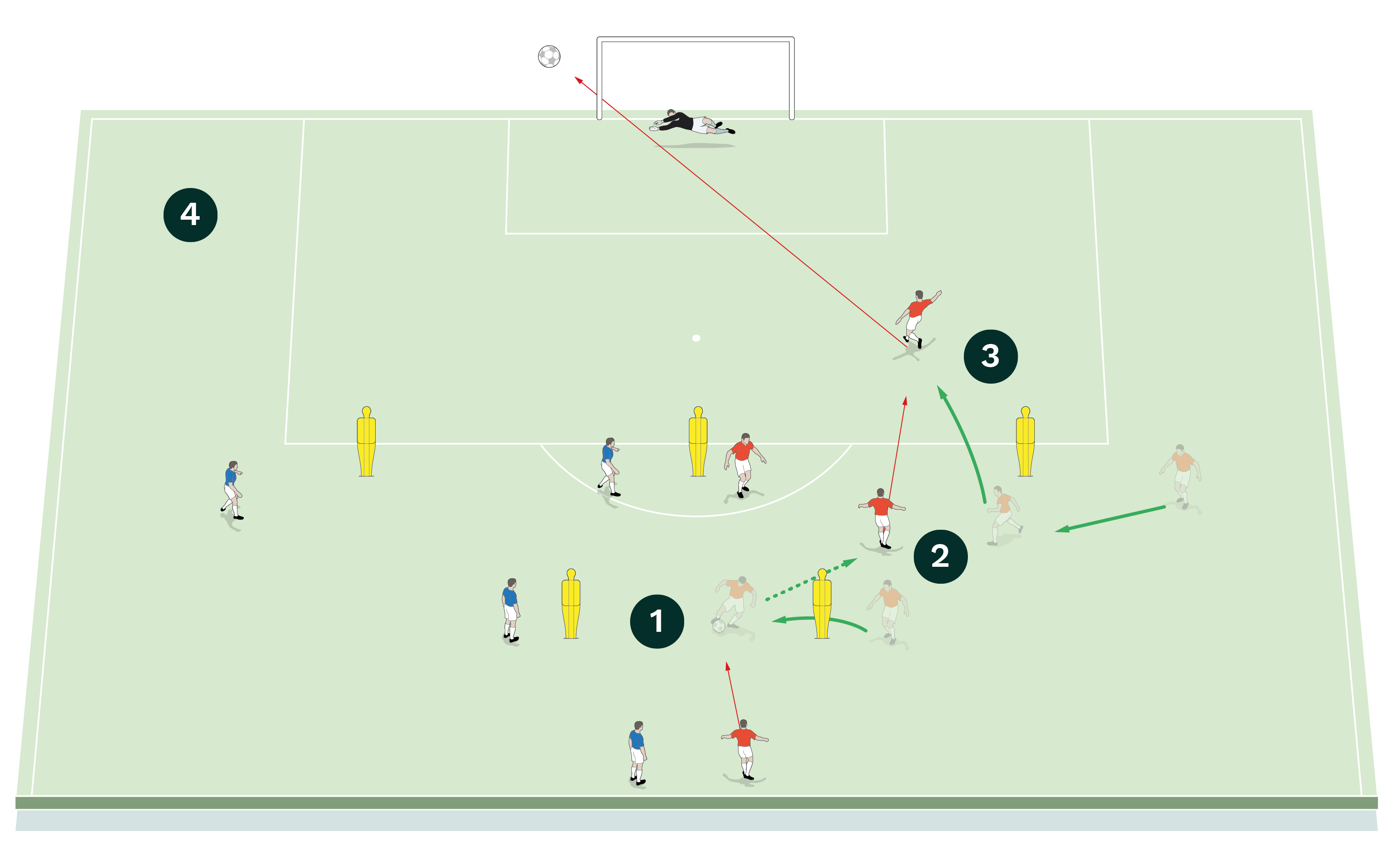
2. The number 8 turns and drives across field with the ball before releasing a through pass for the forward run of the number 7
3. The number 7 has made a blind side run either in behind or across the face of the mannequin to receive and finishes with a shot on goal
4. Repeat all four attacks on the other side with the blues
OPPOSED PRACTICE
We set up on half a pitch with a goal and a goalkeeper in their usual positions at one end and two small target goals at the other end. Two mannequins are positioned as shown, representing defending full backs. Zones are marked on the pitch with flat cones and their importance is explained to the players.
We begin by using 14 outfield players split into a red attacking team of 9 and a blue defending team of 5, set up as shown [2a], with the reds enjoying a 4v3 midfield overload in the combination play zone. They also have a striker breaking out of the combination zone and going up against two blue central defenders in front of goal, plus a wide player in each pocket and an overlapping full back on each flank, ready to attack or cover.
The aim for the red team is to attack by employing similar patterns to those rehearsed in the technical practice and using good decision-making to decide on the best pattern to use. If the blues win the ball at any point during an attack, they must counter-attack one of the two mini goals as quickly as possible. The red attacking team can counter-press immediately on losing possession with the aim of winning the ball back – and if they succeed, they continue to attack using one of the various rehearsed combinations.
The coach starts play by passing the ball into the red team in the central area. To begin with, we are looking for the red attacking team to keep possession in the midfield and then break out and score.
[2a]
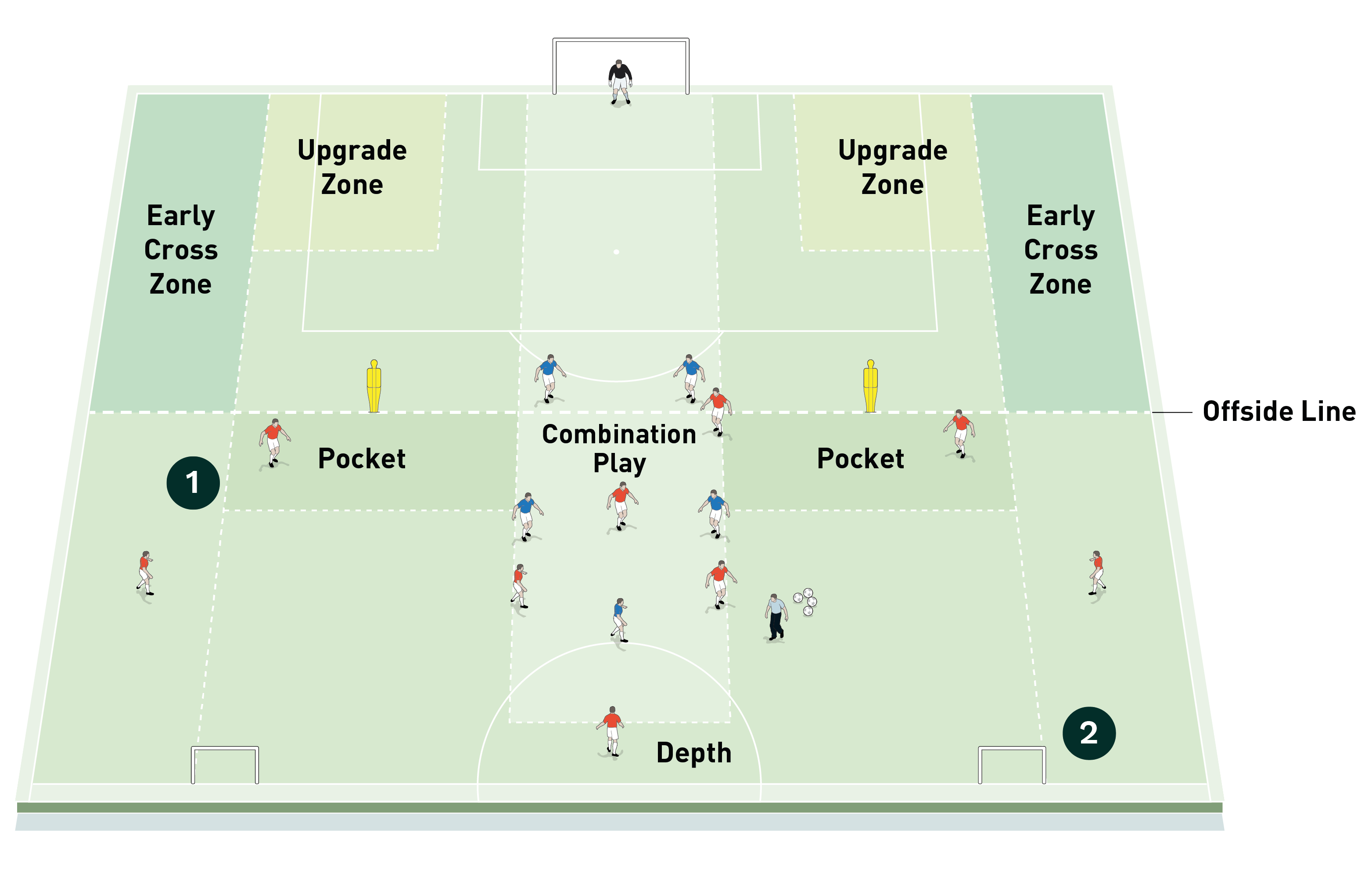
2. The aim for the blues is to try to win the ball back and if they succeed they must counter-attack one of the two mini goals
[2b]

2. Initially the reds have to make five consecutive passes in the central zone in a 4v3 before employing the best attacking pattern for the situation
3. The number 7 begins by coming inside into the pocket to receive and then passes forward to the overlapping full back who receives here and crosses
4. The red number 9 and 10 attack the central zone in front of the goal but it’s the left winger who makes a back post run to finish from the cross
[2c]
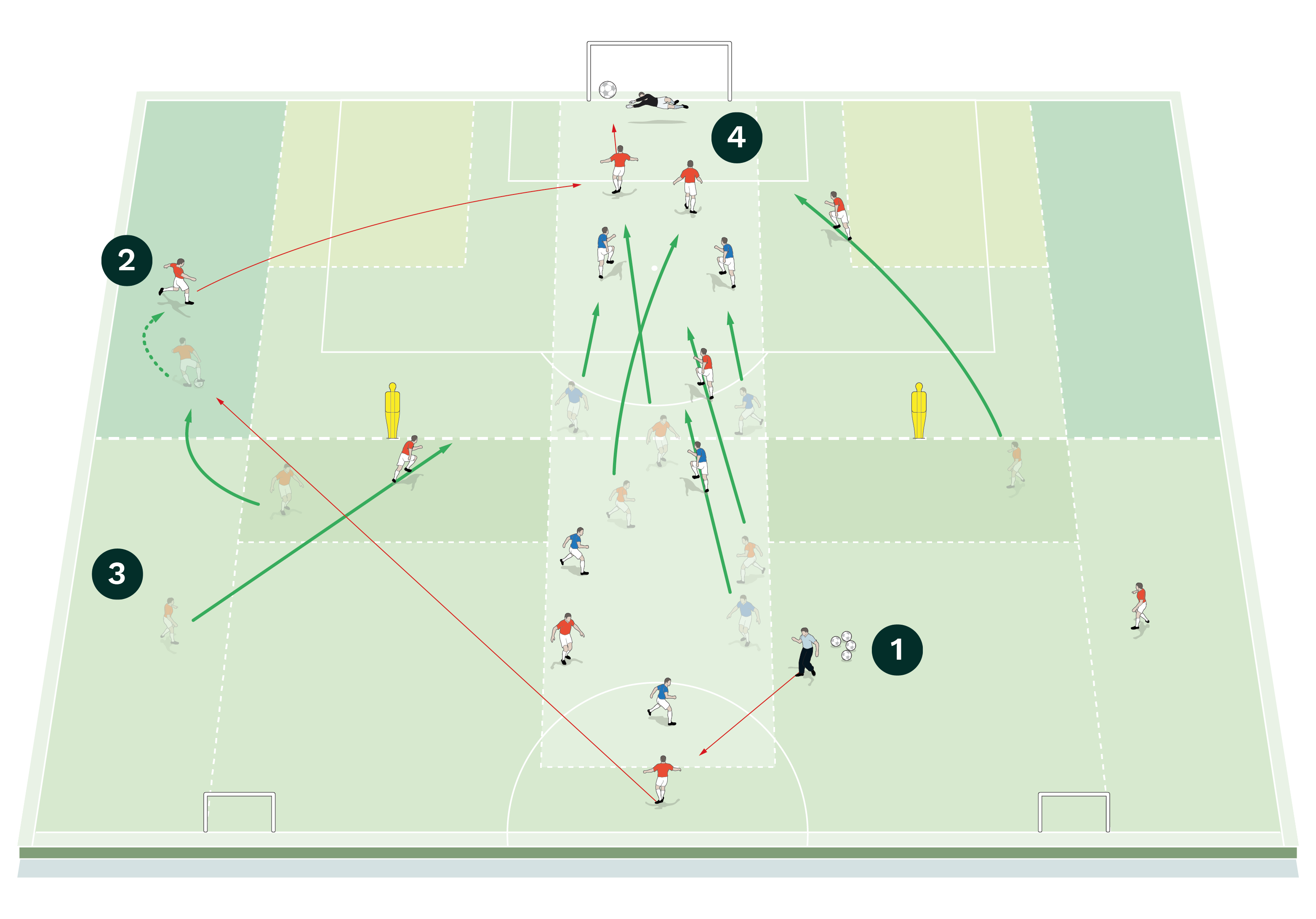
2. The red number 6 sees the best attacking option to be a switch of play to the number 11 who has made a run to receive in the early crossing zone
3. When the winger goes wide, the full back goes inside to pick up any poor clearances to keep the attack alive if necessary
4. The red numbers 8, 9 and 10 and the right winger, attack the key areas in front of goal and one finishes with a shot. A defender can track the red number 8, giving the attackers a 4v3 overload
[2d]

2. The number 9 has a free first touch before the blues can press him and he sets the number 10 for a pass out wide
3. The number 7 has made a run in behind the mannequin to receive and crosses first time from the upgrade zone
4. The red numbers 8, 9, 10 and 11 attack the key areas in front of goal but it’s the number 11 who makes this back post run to finish with a shot on target
To encourage this we initially ask the reds to make five consecutive passes in the central zone in a 4v3 situation before being allowed to play the ball out wide. In this first example, the wide player (number 7) has moved inside into the pocket to receive the breakout pass and then plays it to the overlapping full back, who receives the ball in the early cross zone and crosses into the penalty area. The number 9 and number 10 attack the central zone in front of the goal, but it’s the left winger who makes a back post run to finish from the cross, which can be defended by the two blue centre backs, as shown [2b].
To progress the activity, we remove the five-pass rule. With this change, the coach starts play by passing to the deep lying midfielder (the number 6). On receiving the ball, the number 6 can switch the play directly to the wide players. In this example the wide player (number 11) makes a wide movement to receive the ball in the early crossing zone. The wide player then delivers an early cross for the red numbers 7, 8, 9 and 10 to attack in the key areas in front of goal and one finishes the move with a shot, as shown [2c].
[2e]
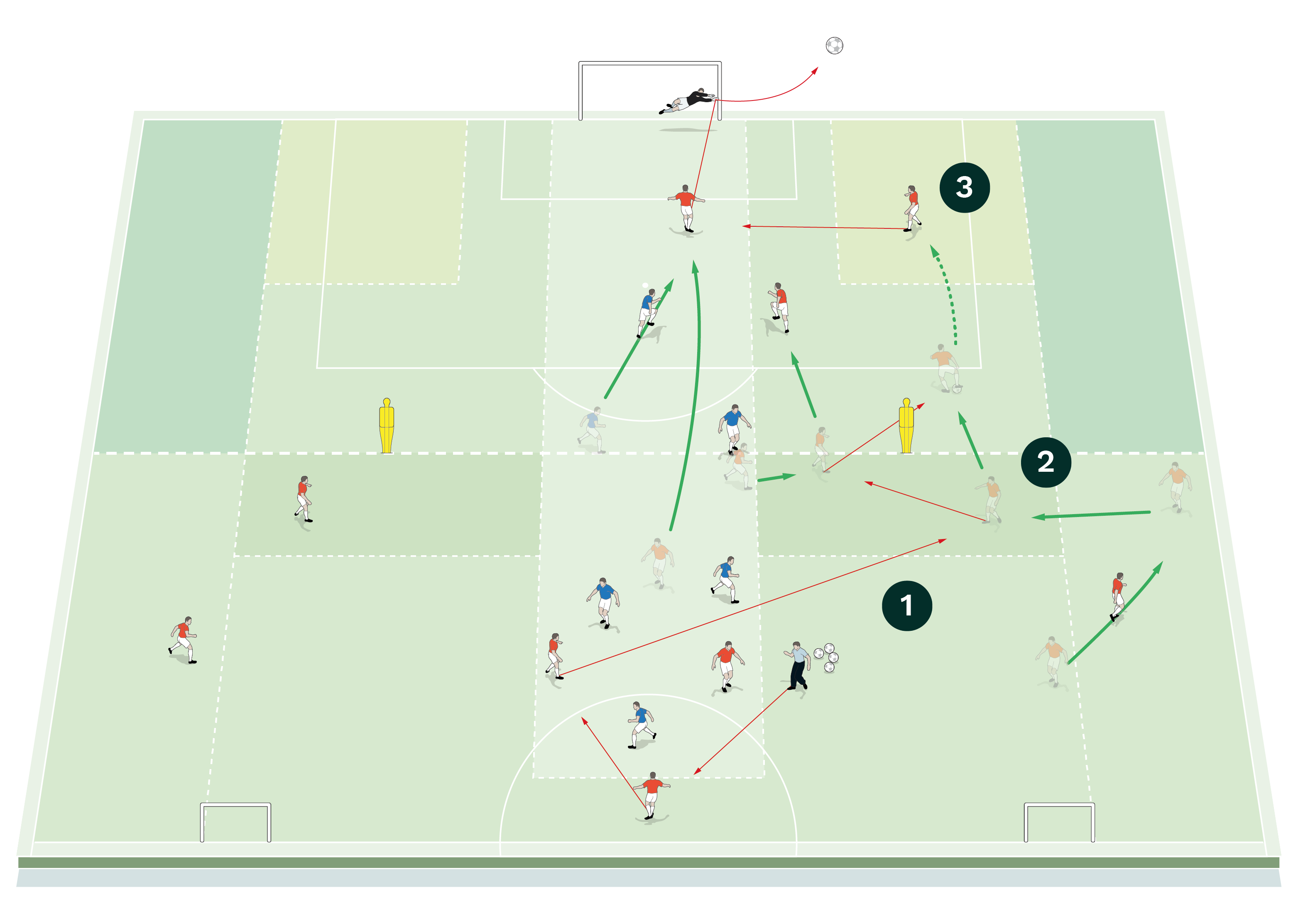
2. The wide player combines with the number 9 using a one-two to get in behind the last defensive line
3. The wide player dribbles into the upgrade zone and crosses for the number 10 to finish first time
[2f]
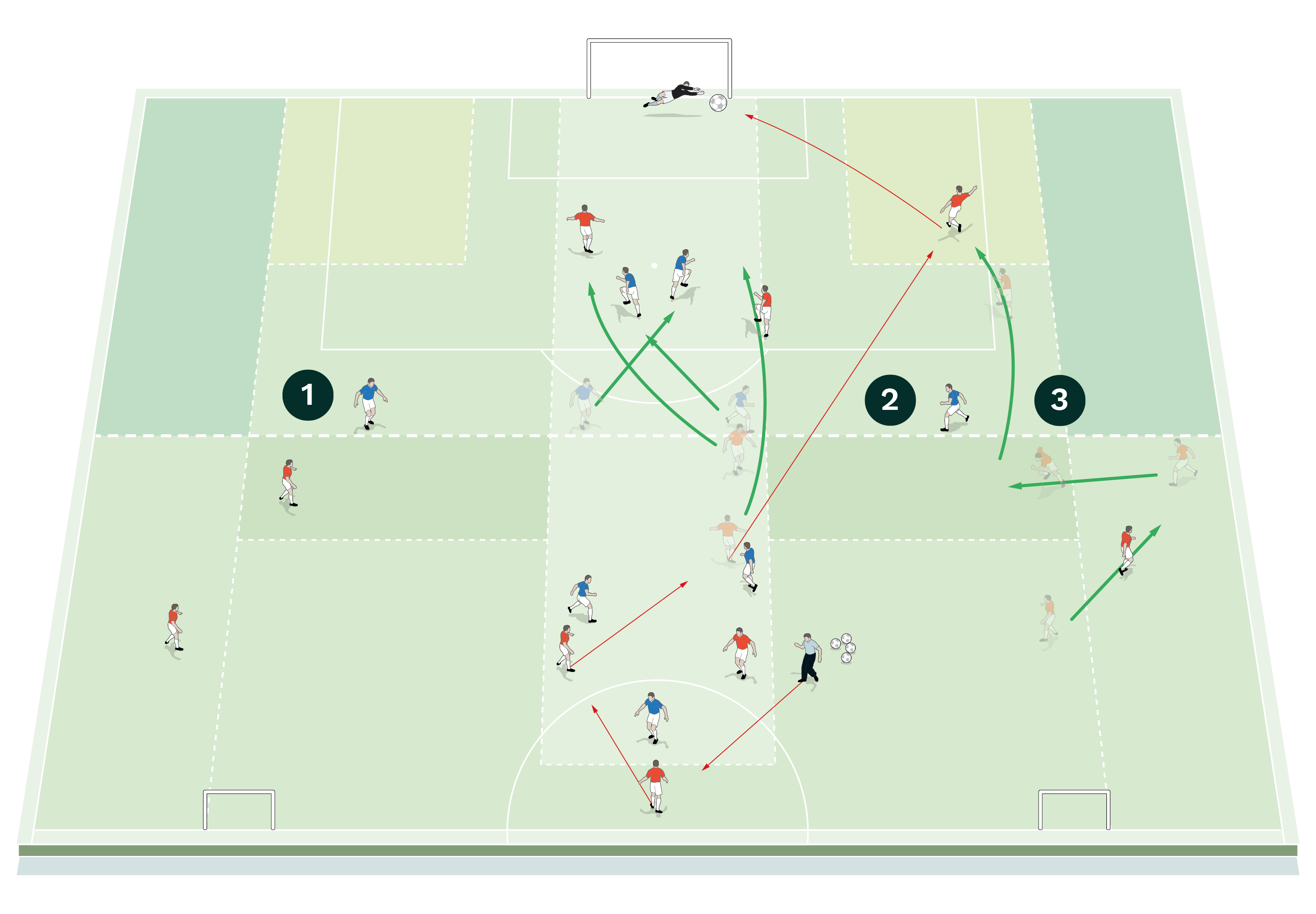
2. In this example the number 8 plays into the number 10, who turns and plays a pass in behind into the upgrade zone
3. The wide player moves into the pocket to show to feet before switching direction and running in behind to receive and shoot from the edge of the penalty box
Alternatively, the reds can build an attack using combination play through the central zone using the number 9 who has a free first touch before the blue defenders are able to press him. As the aim is to produce similar patterns to the technical practice, in this example we show a possible set from the number 9 to the number 10, who plays the ball out wide and in behind the mannequin that represents a defending full back. The right winger then aims to produce a one-touch cross from the upgrade zone. The red numbers 8, 9 and 10 attack key areas but in front of goal but it’s the left winger that makes a back post run and finishes with a shot on goal, as shown [2d].
In the fourth attacking example, the number 6 passes into the central zone, where combination play takes place. A pass is then played into the pocket for a wide player, who has moved inside to receive. The wide player can then combine with the number 9 or the number 10 to get in behind the last defensive line, using a possible one-two combination, as shown [2e].
As a progression, in the fifth attacking example we remove the mannequins and we now add full backs to the blue defending team to offer a tougher challenge to the red attackers. The reds combine to work the ball through the central zone before the number 8 plays into the number 10, who turns and plays a pass in behind and into the upgrade zone. The wide player, who has initially moved into the pocket to show to feet, changes direction and makes a run in behind
into the space to receive and shoots from the edge of the penalty area, as shown [2f].
If the blues win the ball at any point during a red breakout, the blue back line pushes up to the offside line while their team mates counter-attack and try to score in one of the mini goals, as shown [2g]. Once the counter-attack has played out, we could play a second ball into the red number 6 to switch the ball out while the defensive team is unbalanced.
The red attacking team must still counter-press immediately on losing possession and resume their attack if regaining the ball. We play this for 20 minutes before finishing with an 11v11 game.
[2g]
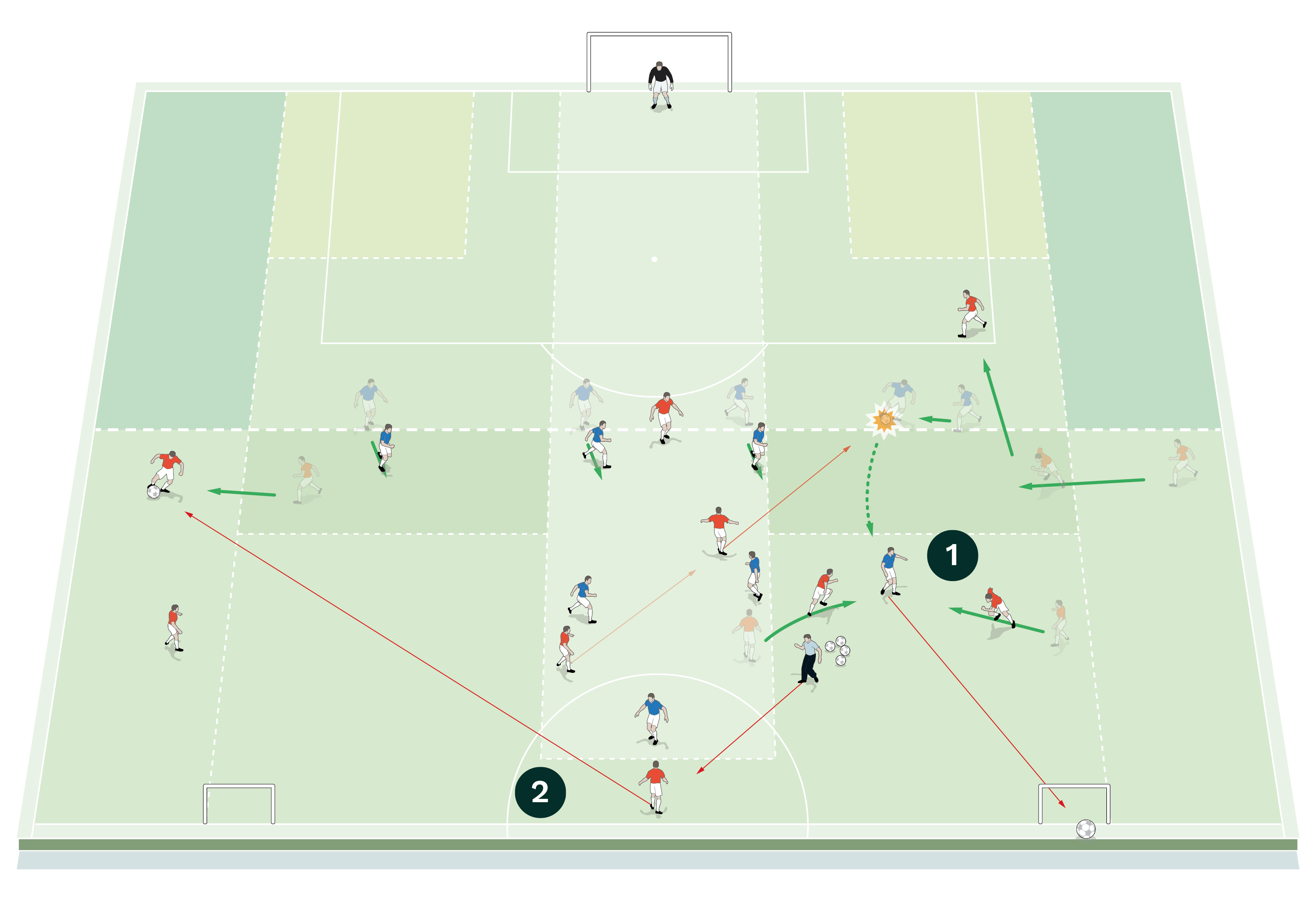
2. Once the blue counter-attack has played out, the coach plays a second ball to the red number 6, who launches an attack while the defensive team are unbalanced
COACHING POINTS
What are the key things to look for?
On the blue defending team we want to see the central midfielders winning possession and playing the ball quickly into a mini goal on the counter. If the blue centre backs win possession they should find a central midfielder or pass into a mini goal directly. We want to see the blue centre backs and central midfielders defending crosses and clearing the ball. If the goalkeeper secures the ball, they should find a team mate to hit the mini goal or hit the mini goal with a throw or kick themselves.
On the attacking team, we want to see quick one-touch and two-touch passing through the central areas and effective combinations between the number 9 and the number 10.
It’s important that we see good movement from the wide midfielders and the full backs, who should make runs on different lines, whether that is into pockets, making overlapping runs or underlaps, or using one-twos, half space runs, or POMO runs to the far post.
The type of crossing delivery is key, whether that is playing the ball across the face of a dropping back line, or using a chipped, driven, or cut back cross.
What are the typical mistakes players might make and how do I avoid them?
The blue defending team may drop too deep too early so encourage the attacking team to play the ball into the feet of one of the red number 9s to make the defenders press from behind. Also, have an offside line and encourage defenders to push up to that point, especially when the ball is at the feet of the attacking team’s deep-lying number 6.
The attacking team may take too many risks so limit the time or the number of balls or attacks and dictate which side they must attack from.
Editor's Picks
Attacking transitions
Deep runs in the final third
Using the goalkeeper in build-up play
Intensive boxes drill with goals
Penetrating the final third
Creating and finishing
My philosophy
Pressing initiation
Compact team movement
Coaches' Testimonials

Alan Pardew

Arsène Wenger

Brendan Rodgers

Carlos Carvalhal

José Mourinho

Jürgen Klopp

Pep Guardiola

Roy Hodgson

Sir Alex Ferguson

Steven Gerrard
Coaches' Testimonials

Gerald Kearney, Downtown Las Vegas Soccer Club

Paul Butler, Florida, USA

Rick Shields, Springboro, USA

Tony Green, Pierrefonds Titans, Quebec, Canada
Join the world's leading coaches and managers and discover for yourself one of the best kept secrets in coaching. No other training tool on the planet is written or read by the calibre of names you’ll find in Elite Soccer.
In a recent survey 92% of subscribers said Elite Soccer makes them more confident, 89% said it makes them a more effective coach and 91% said it makes them more inspired.
Get Monthly Inspiration
All the latest techniques and approaches
Since 2010 Elite Soccer has given subscribers exclusive insight into the training ground practices of the world’s best coaches. Published in partnership with the League Managers Association we have unparalleled access to the leading lights in the English leagues, as well as a host of international managers.
Elite Soccer exclusively features sessions written by the coaches themselves. There are no observed sessions and no sessions “in the style of”, just first-hand advice delivered direct to you from the coach.









